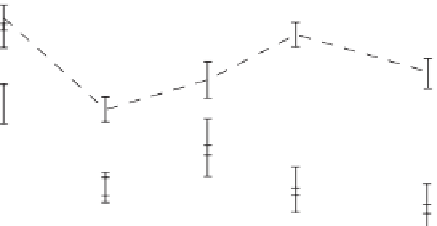Agriculture Reference
In-Depth Information
total abundance and number of weed species in the soil seedbank were increasing
over a 6-year period (1993-1998) in the Conventional and No-till systems but declin-
ing in the Reduced Input and Biologically Based systems. Seedbank increases in
the Conventional and No-till systems were dominated by annual grasses, and a later
study by Menalled et al. (2007) found that carabid abundance and community struc-
tures responded to these changes. They found more total carabids in the Conventional
than in the No-till and Biologically Based systems. However, granivores made up
32% of the total individuals captured in the No-till system but only 4 and 10% of total
carabids in the Biologically Based and Conventional systems, respectively—imply-
ing that more resources were present for weed seed predators in the No-till system.
Menalled et al. (2007) tested this hypothesis by conducting seed removal experi-
ments in these systems and found that predation on seeds of fall panicum (
Panicum
dichotomiflorum
Michx.) and common lambsquarters (
Chenopodium album
L.)
was (1) often more than twice as high in No-till compared to the Conventional and
Biologically Based systems, particularly for fall panicum (Fig. 8.1), and (2) was
closely correlated with seed predator captures (
r
> 0.94). Overall, these studies
(A) Fall Panicum
100
Conventional
No-till
Biologically Based
80
60
40
20
0
(B) Common Lambsquarters
100
80
60
40
20
0
9-Aug
16-Aug
23-Aug
30-Aug
6-Sep
Figure 8.1
. Percentage of seeds of (A) fall panicum and (B) common lambsquarters removed
by invertebrate seed predators in three KBS LTER Main Cropping System Experiment
(MCSE) systems during late summer of 2000 (mean ± SE, n = 6). Each data point represents
a five-day period. Redrawn from Menalled et al. (2007) with permission from Elsevier.













































